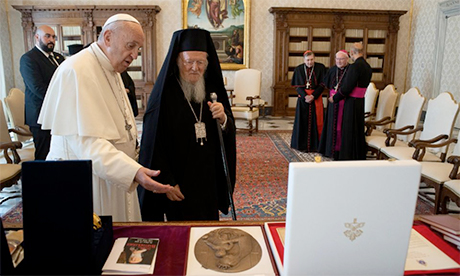Twenty-five years ago, St. John Paul II’s encyclical on ecumenism, “Ut Unum Sint,” put the papal seal of approval on a shift in the Catholic Church’s approach to the search for Christian unity.
For the 30 years from the Second Vatican Council to the publication of St. John Paul’s encyclical May 25, 1995, official ecumenical dialogues tended to focus on comparing and contrasting Catholic teachings or practices with the teachings or practices of its dialogue partners.
The search for what Christians held in common was a necessary first step in recognizing each other as Christians, called by Jesus to be one.
But in “Ut Unum Sint” (Latin for “that they may be one”), St. John Paul said that dialogue is more than “comparing things,” said Bishop Brian Farrell, secretary of the Pontifical Council for Promoting Christian Unity.
Dialogue, St. John Paul said, is “an exchange of gifts.”
In the new approach, which has become known as “receptive ecumenism,” Christians say to each other, “What I have is a gift to you and what you have is a gift to me,” Farrell said.
Recognizing that other Christians have gifts and being willing to accept them as something that could help one’s own community grow in faith takes both individual and collective conversion, the bishop said.
For Catholics, one of the gifts it wants to offer is the ministry of the bishop of Rome — the papacy.
St. John Paul made headlines around the world when, in “Ut Unum Sint,” he invited “church leaders and their theologians to engage with me in a patient and fraternal dialogue” on how the bishop of Rome could exercise his ministry of unity among all Christians.
The papacy and the power involved in exercising papal ministry have been at the centre of division and debate for millennia. It was the key issue in many of the fractures within the Christian community and is still debated within the Catholic Church itself.
While Anglican, Lutheran, Presbyterian and other Protestant churches published responses to St. John Paul’s invitation, the most sustained focus on the papacy has come in the official Orthodox-Roman Catholic dialogue.
Since 2006, the Joint International Commission for Theological Dialogue Between the Catholic Church and the Orthodox Church has been focusing on the history and exercise of the papacy. And the dialogue is ongoing.
But one point St. John Paul made in “Ut Unum Sint” is that the search for Christian unity, which needs theological reflection, cannot stop there. It is not simply an intellectual exercise.
“The theoretical discussions have to solve the question of the balance between jurisdiction and communion,” Farrell said. “But at the practical level, we are living a communion that is normal and positive and visible” every time the pope and other Christian leaders come together to pray, to call for prayers and to advocate for action to benefit the common good, the end of violence and the care of creation.
The pope always has been the pope because he is the bishop of Rome, not vice versa.
But Pope Francis’ constant referrals to himself as the bishop of Rome also have had a positive ecumenical impact.
“I’m sorry that some Catholics think that this is some sort of diminution, some lessening of the dignity or the power of the papacy or something,” Farrell said. “It really is not.”
Francis is “theologically correct” to refer to himself that way, the bishop said, “and from the ecumenical point of view, it helps to put the papacy in its proper perspective.”
“I would dare to say some Catholics have this idea that the pope is somehow outside the church, above it, separate, isolated, whereas Pope Francis keeps reminding us that the pope is a bishop within the church but with particular responsibilities,” Farrell said. Continue reading
